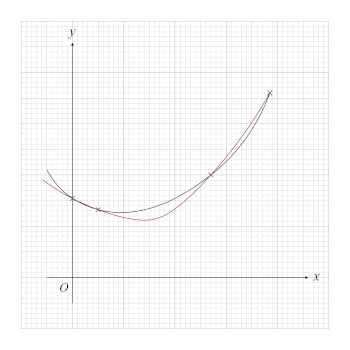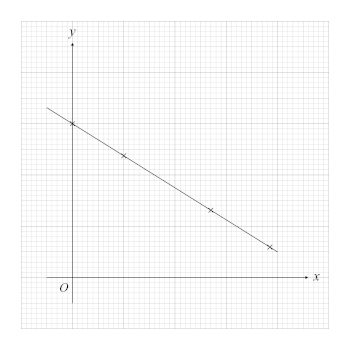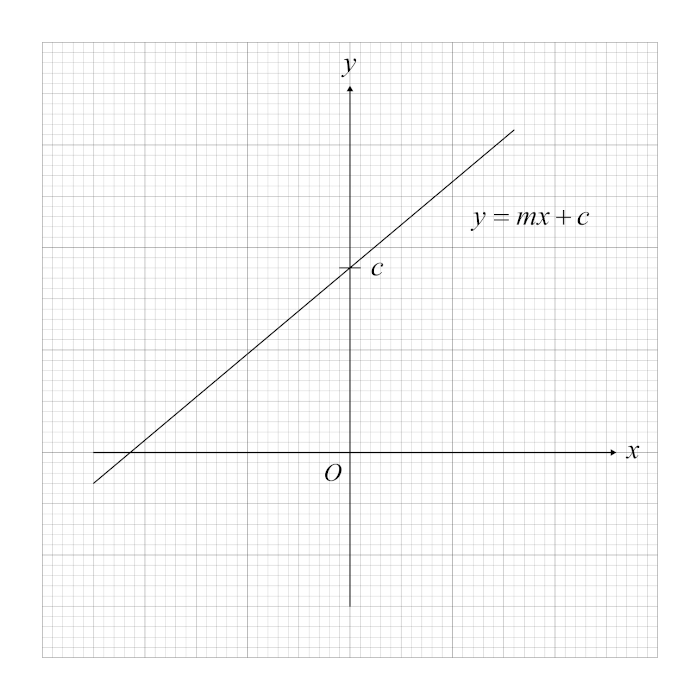Linear Law
In this article, we will be learning about Linear Law. Besically Linear Law illustrates a constant rate of change between variables, forming straight-line graphs, pivotal in various fields for modeling relationships.
Specifically, we will be covering the following:
- Converting Non-Linear Algebraic Equation into Linear Form
- Converting Exponential Equation into Linear Form
- Converting Linear Form of an Equation into Non-Linear Equation
Linear Law
The Linear Law describes a fundamental relationship between two variables, where one changes at a constant rate with respect to the other, forming a straight-line graph. It's expressed by \(\text{y = mx + b}\), denoting the dependent variable \(\text{(y)}\), the independent variable \(\text{(x)}\), the slope \(\text{(m)}\), and the y-intercept \(\text{(b)}\). This law underpins analyses in diverse fields, offering a simple yet powerful tool for modeling continuous relationships.
 (i) |
 (ii) |
When we look at graph (i) above, we see that at the point of turn, there are two possible ways to draw the graph based on the plotted points. However, this leaves a greater room for error as the curve drawn might not be accurate. Hence, a better way to obtain more accurate points is to convert the curve into a straight-line graph.
This is where we will consider Linear Law.
Equation Of A Straight Line
The equation of a straight line, known as the slope-intercept form, is \(\text{y = mx + b}\), where \(\text{m}\) is the slope (rate of change) and \(\text{b}\) is the \(y\)-intercept (value of \(\text{y}\) when \(\text{x = 0}\)). It represents the relationship between the dependent variable \(\text{y}\) and the independent variable \(\text{x}\), forming a straight line when plotted on a graph.

The general equation of a straight line is \(y = mx + c\), where,
Gradient \(= m\)
y-intercept \(= c\)
Let’s consider another equation, \(\displaystyle{y=m \bigg(\frac{1}{x}\bigg)+c.}\)
If we draw the graph of \(y\) against \(x\), we will obtain an exponential graph. However, when the graph of \(y\) against \(\displaystyle{\frac {1}{x}}\) is drawn, we will obtain a straight line.
Converting Non-Linear Algebraic Equations into Linear Form
The linear form of any non-linear equation is given by:
\(Y=mX+c\)
where \(m\) is the gradient, \(c\) is the y-intercept, and \(Y\) and \(X\) must contain only \(x\) and \(y\) variables.
Examples:
\(\begin{align*}
X &= xy \;; &Y &= x^2 &----- &\text{ Acceptable} \\[2ex]
X &= 2x \;; & Y &= \frac{4}{y} &----- &\text{ Unacceptable} \\[2ex]
X &= 2^x \;; & Y &= 3^y &----- &\text{ Unacceptable} \\[2ex]
X &= x^n \;; & Y &= y^n &----- &\text{ Acceptable} \end{align*} \)
| Non-Linear Equation | Linear Form |
|---|---|
| \(\displaystyle{y = \frac{2}{x}-5}\) | \(\begin{align*} y = \;&2\bigg(\frac{1}{x}\bigg)-5 \\ \\ &\text {where}\\ \\ Y = xy, \;X &= x^2,\; m = 2,\; c = 3 \end{align*} \) |
| \(\displaystyle{xy=2x^2+3}\) | \(\begin{align*} xy &=2x^2+3 \\ \\ &\text {where} \\ \\ Y = xy, \;X &= x^2, \;m = 2, \;c = 3 \end{align*}\) |
Question 1:
Complete the table by converting the following equation into linear form \(Y = mX + c\).
Solution:
| Non-Linear Equation | Linear Form | Y | X | m | c |
|---|---|---|---|---|---|
| \(\begin{align*} y=2x^3-x^2 \end{align*}\) | \(\begin{align*} y &= 2x^3-x^2 \\[2ex] y+x^2 &= 2x^3-x^2+x^2 \\[2ex] y+x^2 &= 2x^3 \end{align*} \) | \(y+x^2\) | \(x^3\) | \(2\) | \(0\) |
| \(\begin{align*} y=2x^3-x^2 \end{align*}\) | \(\begin{align*} y &= 2x^3-x^2 \\[2ex] y \div x^2 &= (2x^3-x^2) \div x^2 \\[2ex] \frac {y}{x^2} &= 2x - 1 \end{align*}\) | \(\begin{align*} \frac {y}{x^2} \end{align*}\) | \(x\) | \(2\) | \(-1\) |
| \(\begin{align*} y=3x^2 + \frac{4}{x^3} \end{align*}\) | \(\begin{align*} y &=3x^2 + \frac{4}{x^3} \\[2ex] y \times x^3 &= \bigg(3x^2 + \frac{4}{x^3}\bigg) \times x^3 \\[2ex] yx^3 &= 3x^5 + 4 \end{align*}\) | \(yx^3\) | \(x^5\) | \(3\) | \(4\) |
Question 2:
Convert the following equation into linear form \(Y = mX + c\).
Solution:
The first operation would be to multiply \((2x + 3)\) on both sides.
\(\begin{align*} (2x + 3) \times y &= \frac {x^5}{2x+3} \times (2x + 3) \\ \\ (2x + 3)y &= x^5 \end{align*} \)
The second operation would be to divide by \(y\) on both sides.
\(\begin{align*} 2x + 3 &= \frac {x^5}{y} \end{align*}\)
Hence, \(\begin{align*} Y = \frac {x^5}{y}, \;X = x, \;m = 2, \;c = 3 \end{align*}\).
Product, Quotient and Power Laws of Logarithms
\(\begin{align*} log_ax + log_ay &= log_a(xy) \\[2ex] log_ax - log_ay &= log_a\bigg(\frac{x}{y}\bigg) \\[2ex] log_ax^r &= rlog_ax \end{align*}\)
Converting Exponential Equations into Linear Form
For example, by taking ln on both sides:
| Exponential Equation | Linear Form |
|---|---|
| \(\displaystyle{ y=ae^{bx}}\) | \(\begin{align*} ln \;y &= ln \;ae^{bx} \\[2ex] ln \;y &= ln \;a +ln \;e^{bx} \\[2ex] ln \;y &= ln \;a +ln \;e^{bx} \\[2ex] ln \;y &= ln \;a +bx\; ln \;e \\[2ex] ln \;y &= bx+ln \;a \\[2ex] \therefore \quad Y = ln \;y&, \;X = x, \;m = b, \;c = ln \;a \end{align*}\) |
Question 3:
Convert the following equations into linear form \(\begin{align*} Y = mX + c \end{align*}\):
- \(\displaystyle{y = 2^{3x}}\)
- \(\displaystyle{y^x = 5e^{–3x}}\)
- \(\displaystyle{y = x^2 + e^x}\)
Solution:
- For the equation \(\begin{align*} y = 2^{3x} \end{align*}\)
\(\begin{align*} ln \;y &=ln \;2^{3x} \\ \\ ln \;y &=3x \;ln \;2 \\ \\ ln \;y &=(3 \;ln \;2)x \end{align*}\)
Therefore, \(\begin{align*} Y = ln \;y, \;X = x, \;m = 3\;ln \;2, \;c = 0. \end{align*} \)
- For the equation \(\displaystyle{y^x = 5e^{–3x}}\),
\(\begin{align*} ln \;y^x &= ln \;5 \;e^{-3x} \\ \\ ln \;y^x &= ln \;5\;+\;ln \;e^{-3x} \\ \\ x \;ln \;y &= ln \;5\;+\;(-3x)ln \;e \\ \\ x \;ln \;y &= ln \;5-3x \end{align*}\)
Therefore, \(\begin{align*} Y = x \;ln \;y, \;X = x, \;m = −3, \;c = ln \;5. \end{align*}\)
- For the equation \(\begin{align*} y = x^2 + e^x \end{align*}\),
\(\begin{align*} ln \;(\;y\;-\;x^2\;) &= ln \;e^x \\ \\ ln \;(\;y\;-\;x^2\;) &= x \;ln \;e \\ \\ ln \;(\;y\;-\;x^2\;) &=x \end{align*} \)
Therefore, \(\begin{align*} Y = ln \;(y - x^2), \;X = x, \;m = 1, \;c = 0 \end{align*}\)
Conclusion
In this article, we have learnt of the significance of converting non-linear equations in linear form. More specifically, we have learnt how to convert a non-linear algebraic equation and an exponential equation into linear form \(y = mx + c.\)
Be careful when manipulating a non-linear equation algebraically! For exponential equations, make sure the laws of logarithm are applied correctly to minimise errors.
A last important reminder is that \(Y\) and \(X\) should only contain \(x\) and \(y\) variables, while \(m\) and \(c\) should not contain any \(x\) or \(y\) variables. If this condition is not met, try converting the non-linear equation into a different linear form.
Keep learning! Keep improving!


 SG
SG  VN
VN 














